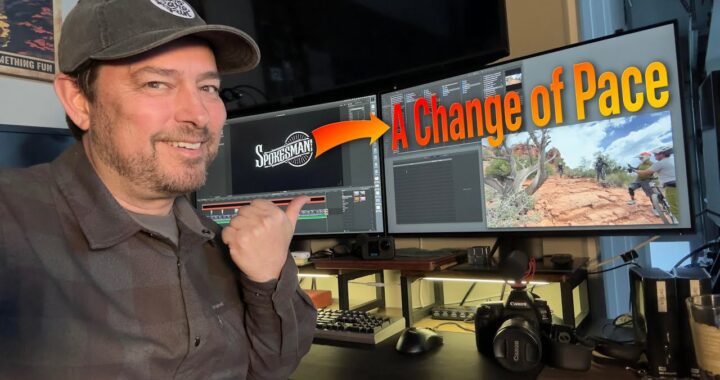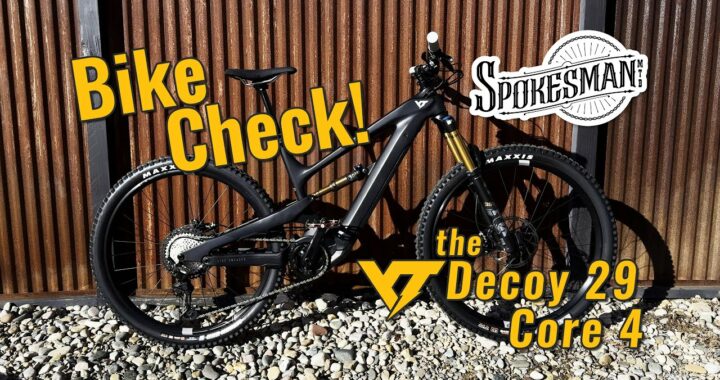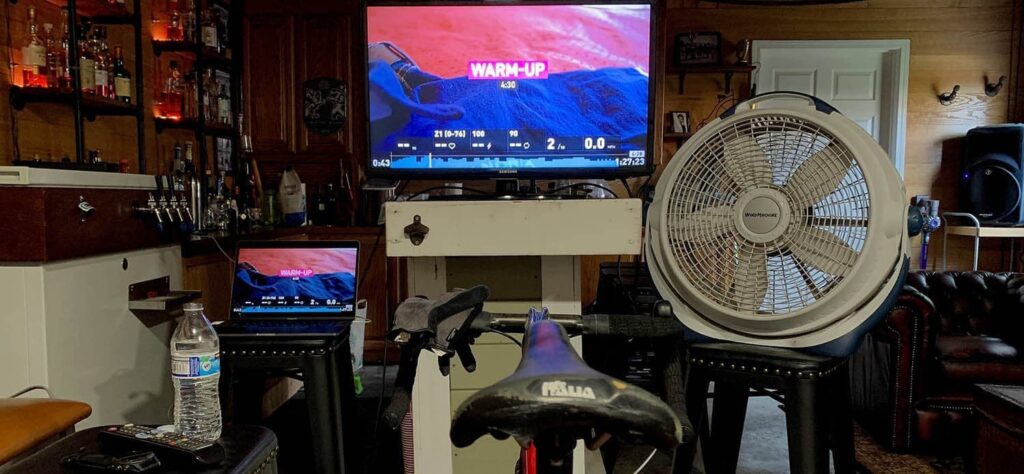
It’s been a few weeks since I damaged my right hand in a silly and stupid crash while riding with my Son at a local bike park. Aside from a pulled back muscle and the well-earned abrasions I received (some of them very annoying), I seem to be recovering well. It turns out my hand contains no broken bones, only a fairly serious sprain which is healing nicely. There is still pain, but overall range of motion is very good and I am able to enjoy most activities which require use of my hands.
Being unable to ride has been rough. Not only am I unable to work off some of the weight I added during the holiday season, I also found it very difficult to work on the bike and use my hand to type and use the mouse. Being injured makes life even more difficult since I work in photography and I spend 6 hours a day using Photoshop. Things are looking up! Typing is not as hard as it was a week ago, and I can get a full work day in if I pop a few naproxen sodium tablets in the evening.
Riding outdoors is inadvisable for the next few weeks. Any chance of falling, however small they may be, make re-injury a non-zero possibility and remove rides from the table. Couple that with wet and icy conditions and I may be off the bike for another month. I hope that’s not the case, but only time will tell when I can hit the trails again.
While I’m stuck inside, I must focus on indoor training. I have several options on this front and none of them are as much fun as touching real dirt with my tires.
Should I Use the Rollers?
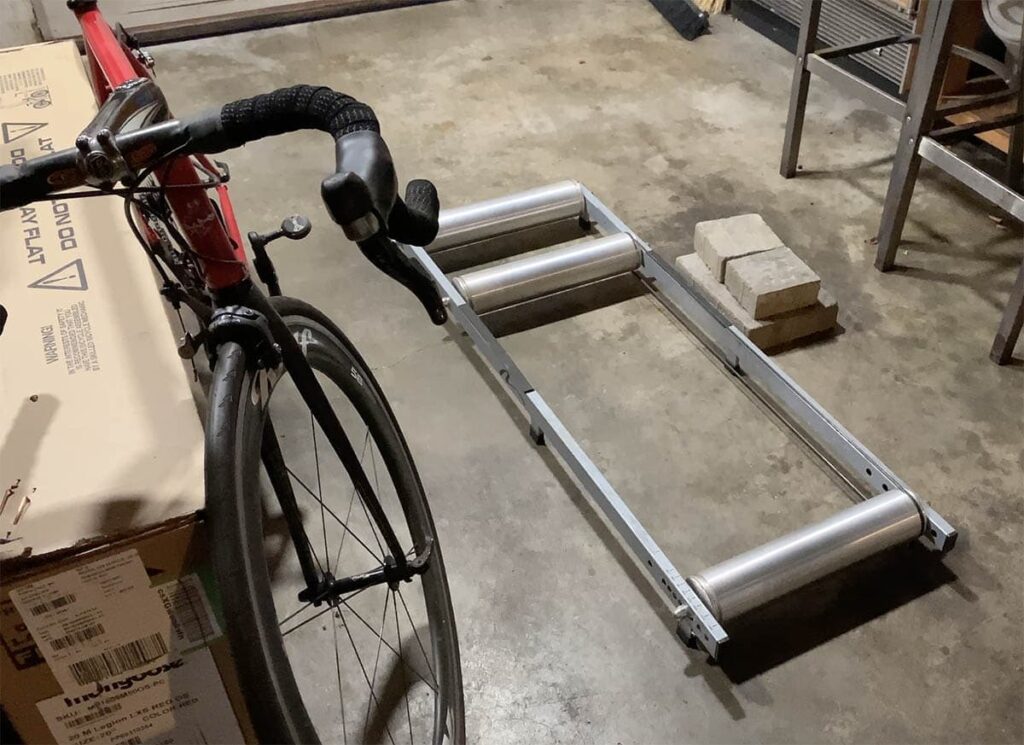
When the rain is coming down too hard for outdoor riding, I use a set of rollers. Our mediterranean climate prohibits a lot of off-road rides during and after rains because the trails can pool with water and rut out, making them wear faster and more difficult/dangerous to ride during the warmer months.
Using rollers eliminates the impact on the local ecology. They also help tune the rider in the areas of endurance and balance (you maintain your own balance while riding them). The balance advantage is somewhat unique to rollers and cannot be understated enough. The benefits are incredible. They help with maintaining a good line when riding road, and they also carry over to dirt riding. Any road rider who rides rollers is going to have an added weapon in their arsenal when those Sunday rides start back up again.
Rollers are a trick to use if you have never tried them before. They require minimal set-up, but must be used with caution. The rider must maintain balance while riding and there is always the danger of tipping over. While an experienced rollers-rider does not need to worry about this very much (I have not fallen off my rollers in several years), the danger exists nonetheless.
So rollers are not an option. I cannot risk re-injury.
What About Trainers?
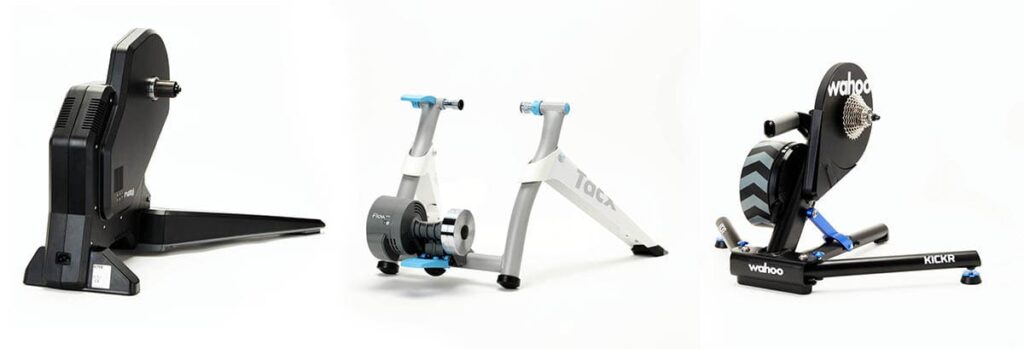
The world of trainers is complicated and diverse. From old-fashioned “exercycles” to wind-trainers to modern magnetic-resistance “indoor bikes” (i.e.; Peleton bikes), they all have advantages depending on whether you are looking for performance, quiet, or price.
Several of my riding buddies, in hopes of training for 100+ mile gravel ride events, recently purchased direct-drive trainers that have some pretty impressive features. They support external electronics (bluetooth and ANT+), have integrated power meters to measure wattage on the fly, dynamically control resistance, and even simulate road texture like boardwalks and cobblestones. Most operate up to (and a bit beyond) 2000w which makes them great tools when benchmarking your baseline “FTP” (Functional Threshold Power) score.
I asked these guys to fill me in on their various models’ pros and cons, helping me make a decision as to which one to purchase. A deep study of DC Rainmaker’s smart trainer shakedown also helped a great deal. There is a lot of information out there already, so I won’t go into too much detail regarding features, price, and performance.
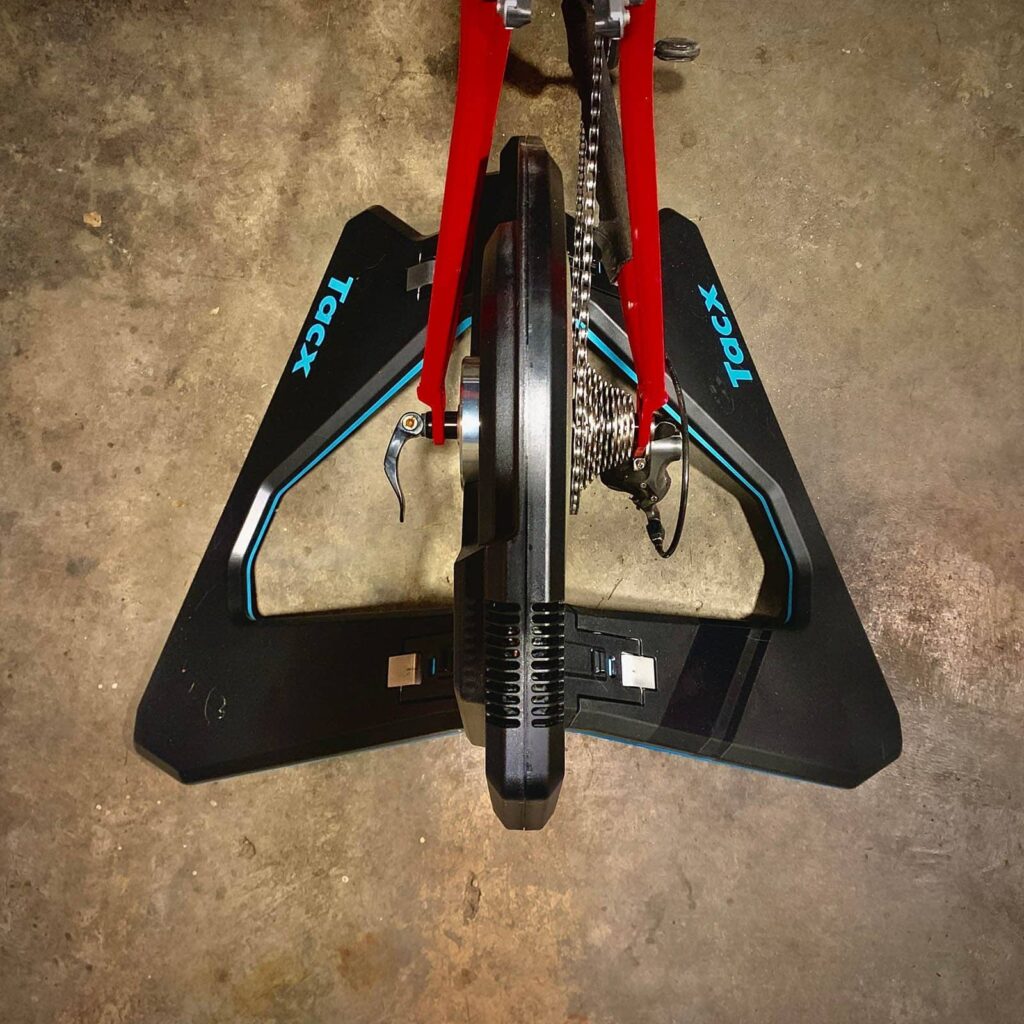
After my homework, I decided to purchase a Tacx Neo 2T. Although the price is a bit steep, it has lots of features I really like including great integration with devices I already own (with the purchase of a $13 ANT+ USB dongle for my Macbook Pro), amazing road feel, efficient storage, and super quiet operation. Couple this with the fact that they were recently purchased by Garmin and I was left looking for any kind of downside to this purchase.
I brought it home and set it up in a matter of minutes. It’s heavy, but fairly easy to figure out – even with one hand. Unfold the leg fins, plug it in, and pair it with your chosen software (more on that later). Easy peasy.
Getting the bike ready was a different story. I had to pull the 9-speed cassette off my Ultegra-equipped bike and put it on the trainer. Getting that thing removed was a difficult task. Using only one hand, I had to break loose the sprockets that had been notched into the freehub body through years of use. I had to use a chain whip to pop them off the housing one at a time. The cassette was not damaged, but I need a new housing.
With a spacer (provided in the box), the cassette slid right onto the trainer. I put the bike on using the quick-release skewer, adjusted the rear derailleur, and I was ready to go.
Software
Until this moment, the only equipment I had ever used to train on a bike was an old wind trainer and my rollers. Both had a very specific feel, becoming slightly more difficult to pedal purely depending on your wheel speed (more so with the wind trainer than the rollers). Magnetic-resistance smart trainers are a completely different beast.
Smart trainers can be tuned to work in many different ways. Using software to manage a ride will typically program a resistance regimen that mimics real-world conditions. If you are willing to turn off external software control, then it appears that using the gears increases resistance and can be used in situations where software might not be available or may not be necessary (like computing FTP scores).
I reviewed several software options with the objective of finding the one that best-suited my personal riding style and process for improvement. There are several to choose from.
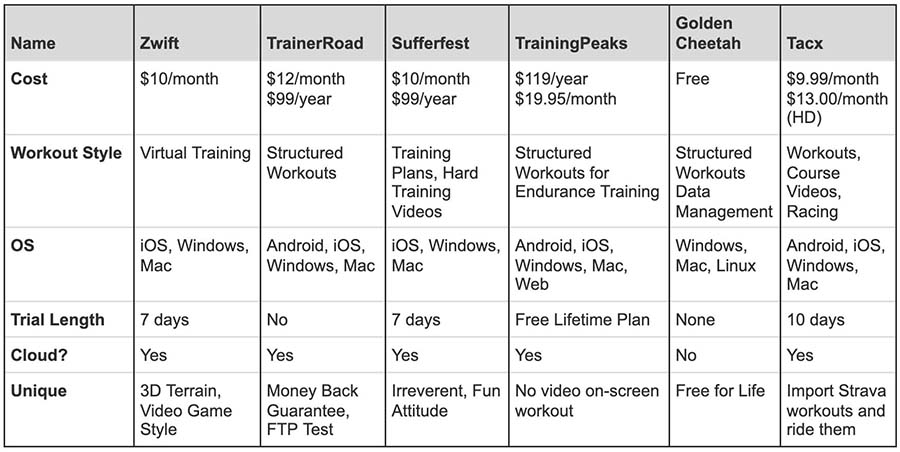
I rode with Zwift for one day and noticed a few things.
- The in-game graphics lacked in terms of quality – there was always a cheap feel
- Two separate apps were required on the iPhone; one remote and one training app – this could easily just be one app (there are people who disagree with me on this point)
- The online store does not work at all if you use an ad-blocker in your browser
- Advancing in the “game” makes riding easier through earning new equipment (i.e. lighter bikes) – counterintuitive when compared to real workouts
- Their support chat is not responsive – it takes a full day to get a response (not much of a chat)
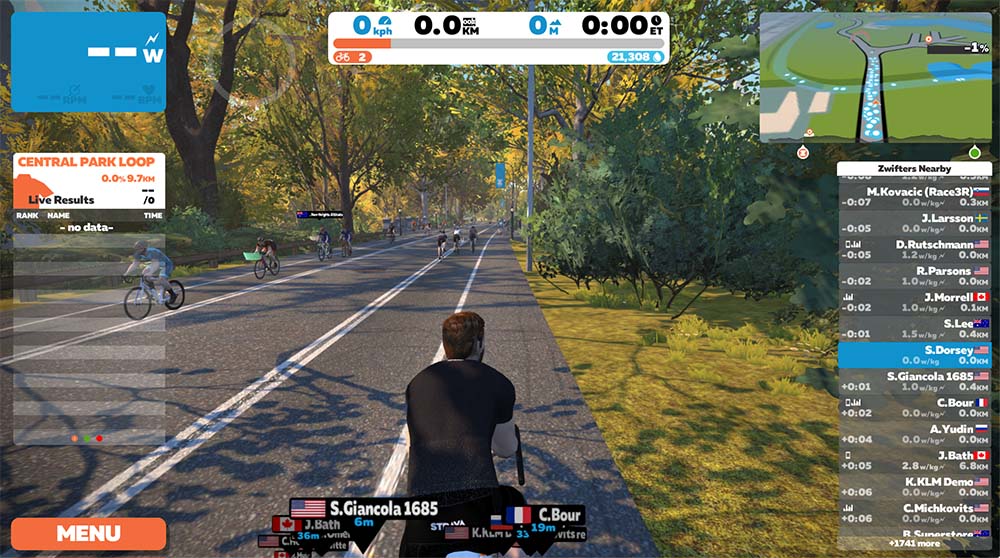
I don’t use a browser without an ad-blocker. To have an online store that literally breaks when an ad-blocker is used is beyond my ability to comprehend and borders on downright irresponsible. Also, the in-game collision detection is very poor. When your character is passing another (live) character, the two riders partially intersect. If a rider were to pass this close in the real world, a crash would happen every single time.
I have a few co-workers who love Zwift’s video game-like styling and scoring. I understand why that is desirable, but it takes a lot more than that to keep my interest. I’ll probably keep my Zwift account open, but mostly just for fun and to ride with friends. I might even cancel it in the Summer months when I won’t be getting much use for the cost.
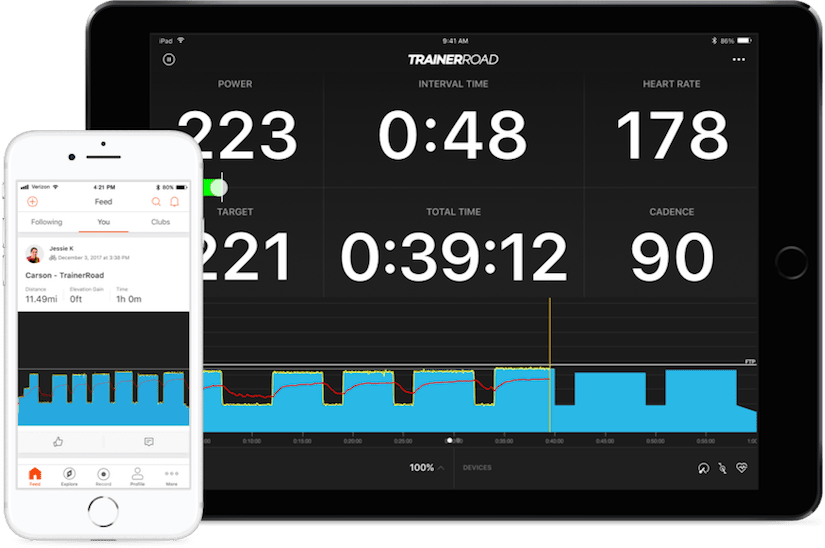
TrainerRoad, while the most comprehensive item on the list, is a bit more than I’m ready to sign up for. I did set up an account and try to start a ride so that I could experience the interface (they don’t have a free trial, so WTF?), but their system cannot use my Garmin Fenix 3 HR as a heart rate monitor, so I decided to opt out before I wasted too much time on a service I wasn’t going to use anyway. They are one of the only options that does not provide footage to view while riding. That is disappointing to me mostly because I love the distraction of the video when I need to hold pace. I don’t doubt that their workouts, podcasts, and advice are well tailored and have a high production quality, but I’m just not part of their demographic of super pro, more serious riders.
TrainerRoad may be the best option if you are looking for a solution that is more in line with pro training. Its hands-on approach is being embraced by athletes who want direct, professional feedback on a ride. Pro riders and those who train for massive endurance events would likely choose this service over the others.
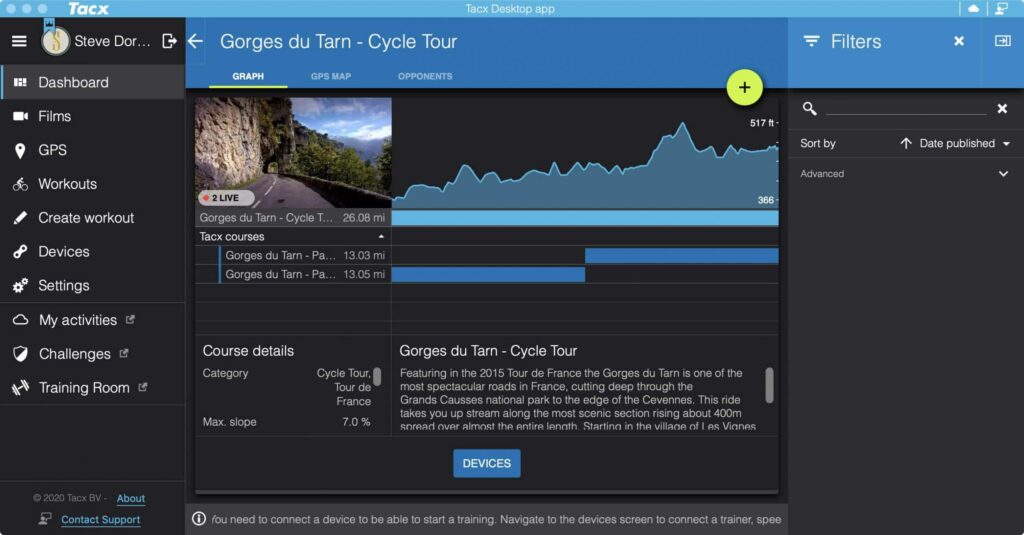
The Tacx service is run (and now owned) by Garmin through the folks at Tacx and likely is part of the reason for the purchase. Garmin, while being an industry-leading athletic equipment company (in their sector of head units and GPS systems), never really had a workout program that utilized indoor trainers and routing. Tacx solves that issue. There aren’t many routes compared to other services, but it looks like they are working on adding to the library.
Tacx offers two pricing tiers. I do not see the sense in charging an additional few bucks each month for HD content – HD should be standard. Having said that, the cost isn’t prohibitive unless you are subscribing to other services as well. In that case, I wouldn’t add this to my lineup mostly because it doesn’t lend enough to my existing subscriptions make it worth the cost. As a stand-alone solution, it just might work well.
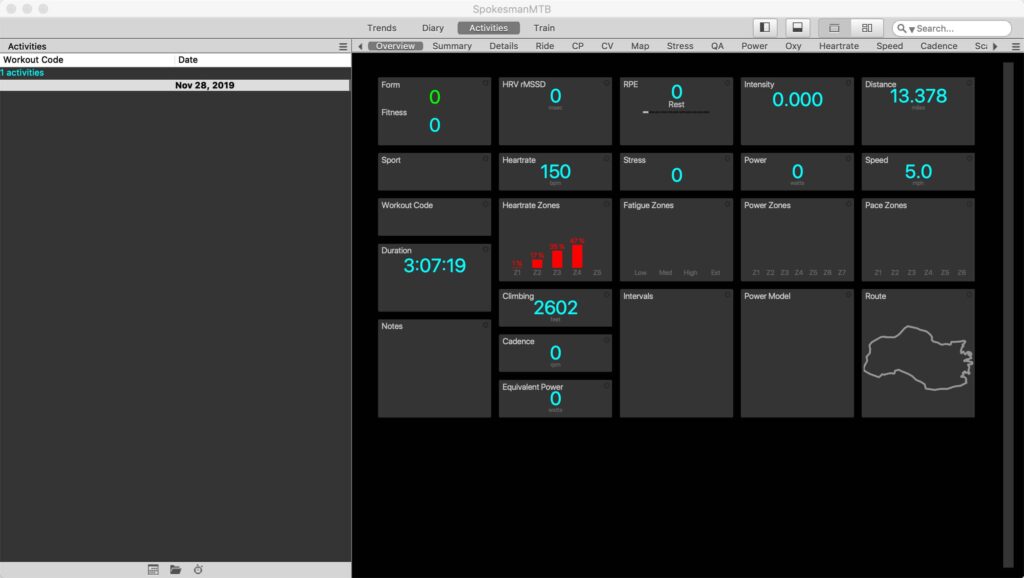
Golden Cheetah sounds like an urban strip joint, but it is actually a free utility for analyzing existing workouts and developing training plans. It even has an interface you can use along with your smart trainer to ride workouts that can access your own video sources to play during the training session. The interface was designed by software programmers, so it has a learning curve, but it seems to work well.
Although it contains a lot of very powerful and well-developed data analysis tools, I feel like the interface is a bit too clunky for my casual needs. You can open virtually any downloaded or generated file format (Garmin, Strava, and many others) and view the raw data as charts and graphs. It is definitely a fantastic free option and is likely the perfect solution for many who want a customized and data-heavy workout tool that is not encumbered by a typical paid plan’s marketing.
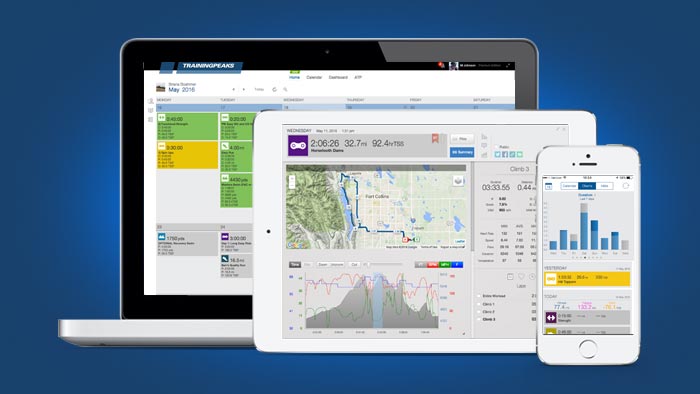
TrainingPeaks is more aligned with workout tracking and building plans to achieve a specific goal (like a triathlon, marathon, or race). It does not have integrated workout video the same way that Zwift, Golden Cheetah, and TheSufferFest do. TrainingPeaks instead focuses on specific strategies and plans to get to a realistic goal from your existing state of fitness. The paid plan gives you far more options like customized training plans which can be loaded directly onto your preferred device.
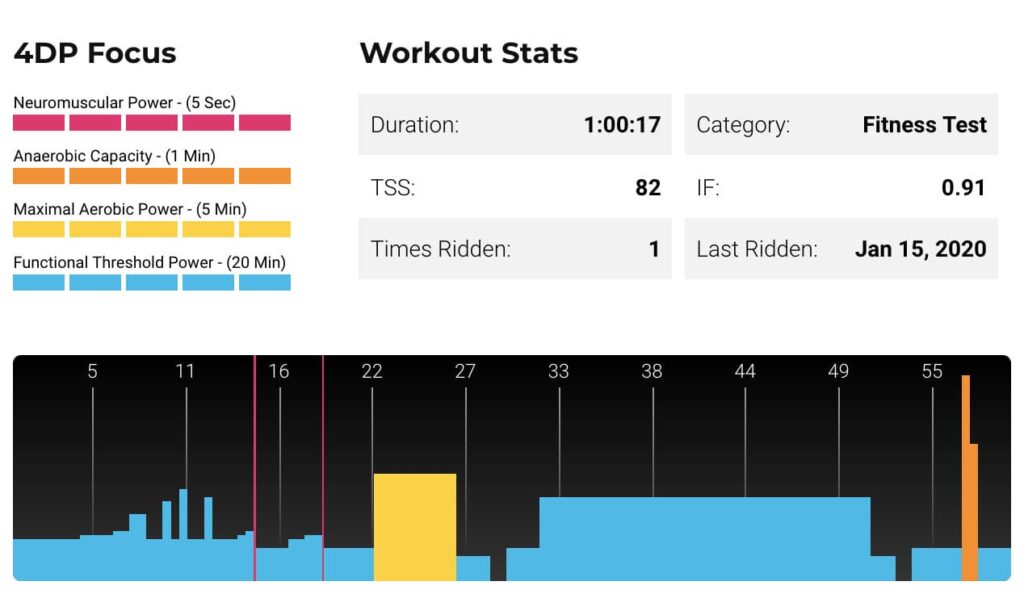
TheSufferFest seems to meet all the other options in the middle. I feel it is a good compromise between hard-core and fun. Their workouts are serious, but are able to laugh at themselves. Workout names like “A Very Dark Place” and “Long Scream” really peak my interest and look like they might be fun to pursue – in a painful, self-hating sort of way. This is definitely my pick.
The service includes videos, workouts, data analysis, and scheduling tools which help tailor workout plans for specific goals (if that’s what you need). Their archives extend beyond simple training plans and include forums, articles, and goal-based achievements. Personally, I liked the article on how to handle returning to the bike after an injury. These guys get it.
TheSufferfest has been around for a long time. I remember when it was launched back in the 90’s when I was riding a lot more on the road. My riding pals were very excited and we were all loving the irreverence of the marketing materials that were being released. TheSufferFest looks like it has matured well and not lost much of its edge.
Spinning
Initial fitness level (referred to as FTP, or Functional Threshold Power) is measured using a sustained effort over a certain amount of time. In most cases, it is measured as a 95% maximum power output sustained over 20 minutes. This final score reflects the number of watts you can sustainably output and your training plans are developed using your FTP as a baseline. You need to regularly re-take your FTP test as you improve in order to keep your training in line with your abilities.
TheSufferFest users are known as “Sufferlandrians” and all share the desire to destroy their enemies. They train hard, ride fast, and drink the finest fictional water from their “Sufferlandrian Springs”. Their native language is “Painglish”. It is an ethos that binds the users together and builds a remarkable amount of morale among the user base.
Their call to action is “I will beat my ass today to kick yours tomorrow”.
Riding with TheSufferFest was fun. My first ride consisted of a basic benchmark test called “Full Frontal”. This one-hour jaunt consists of a ride which warms you up for about 30 minutes (with a series of sprints and a short time trial), gives you a full FTP test for 20 minutes, then has a 10 minute cooldown that contains one HARD sprint.
This sets you up with a “4DP” (4-dimensional Power) baseline that is used by TheSufferFest to tailor your workouts to your abilities, much in the way an FTP score does so on other services. TheSufferFest states that the 4DP profile is more comprehensive than a standard FTP profile and allows them to better personalize training regimens. Whether or not that is true may be subjective. I’m in this for the fun and pain, not for specific stat tracking (although I do like to gaze at the numbers sometimes).
I had to set up my trainer (using TheSufferFest in-app prefs) to NOT run in “ERG” mode (in which the trainer’s resistance is controlled by the software). I also turned off auto-pause (which stops the workout if your flywheel stops). This makes sense – the Full Frontal workout actually asks you to get off the bike and walk around for a minute or two twice after tougher segments. My trainer was essentially set to work in “manual” mode; if I shift into a higher gear, the flywheel gets harder to turn and vise-versa. Doing these things helps the test measure at a more baseline level without interference from the software.
The ride started out pretty simple, spinning in place and reading the instructions on the screen as they appeared. I was prepared for the ride and told when the increases in difficulty would come. In the background, I got to watch footage of famous riders in well known races like the Tour De France and the Giro D’Italia. They all looked as miserable as me – but they were getting paid to look that way. I was literally paying others to be this tired.
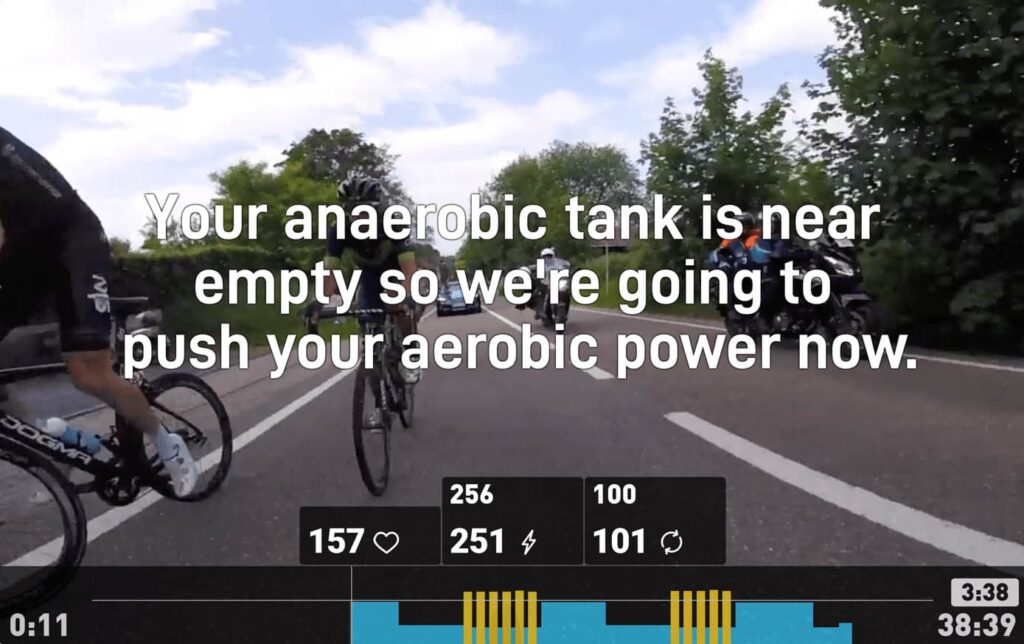
As the workout ramped up, I could feel the resistance increase on the flywheel. The Tacx smart trainer did a fantastic job simulating the conditions of the workout. Hills felt more like hills, and coasting was almost effortless in comparison.
During the sprints, I had a hard time standing up on the bike. Since my frame was locked into a heavy stand, it did not move with me as I pumped. This felt rigid and uncomfortable, and it put strain on my wrist that I really didn’t expect or want. But it wasn’t a deal breaker. I was able to ride fairly well and with an acceptably low level of strain and distraction.
The FTP segment of the workout was easily the toughest. I was sufficiently warmed up and I was as ready as I could be for the segment. The on-screen instructions stressed that the FTP number is determined by a MAXIMUM SUSTAINED EFFORT, not an average of highs and lows. It was incredibly important to find that wattage level that was possible to maintain for a full 20 minutes without any major spikes or dips. This would ensure a better overall reading at the end of the session and allow for better-tuned workouts in the future.
These guys wanted me to be completely spent at the end of the 20 minute FTP. I had to have almost nothing left at the end of the segment. An ability to sprint – even a little bit – would mean that the number I chose was inaccurate and that I should test again. Using the first half of the workout as reference, I chose an even 200 watts to try to maintain for the duration of the FTP portion of the 4DP workout. That number felt like it was probably close to what I could achieve.
Rolling for the first 3-4 minutes was rough but not too bad. I felt confident that a 200 watt FTP was achievable. In fact, I worried a little bit that I may have chosen too low a number. My assumptions were put to rest as the minutes passed.
Five minutes in, I started to feel some strain. As I approached 10 minutes, I was sweating a lot and thankful that I had set my garage fan to the “medium” setting rather than “low”. My legs were complaining and my lungs were starting to gasp. I tried to settle into a rhythm and watched the race footage on the screen as a distraction.
At 15 minutes, I felt pretty spent. I could tell that I was working my legs near their maximum and that I was going to feel this the next day. All in the name of fitness!
As I approached the 18 minute mark, I felt like I was going to complete the test, but just barely. The 200 watt objective wavered on the screen as I labored to hover consistently above and below it. The temptation to stand out of the saddle was huge, but I resisted. After all, you are a more efficient pedaler sitting down than standing up. I pressed on, but my lungs wanted to stop. Air became scarce and my leg strain reflected my oxygen-debt. I hit my anaerobic capacity.
The seconds ticked down and I finally hit the 20 minute mark. I wondered if I could have sprinted at the end. The oxygen bankruptcy and burning in my lungs and legs told me I had hit the nail on the head. 200 watts was accurate enough and this was confirmed by my final score of 199.
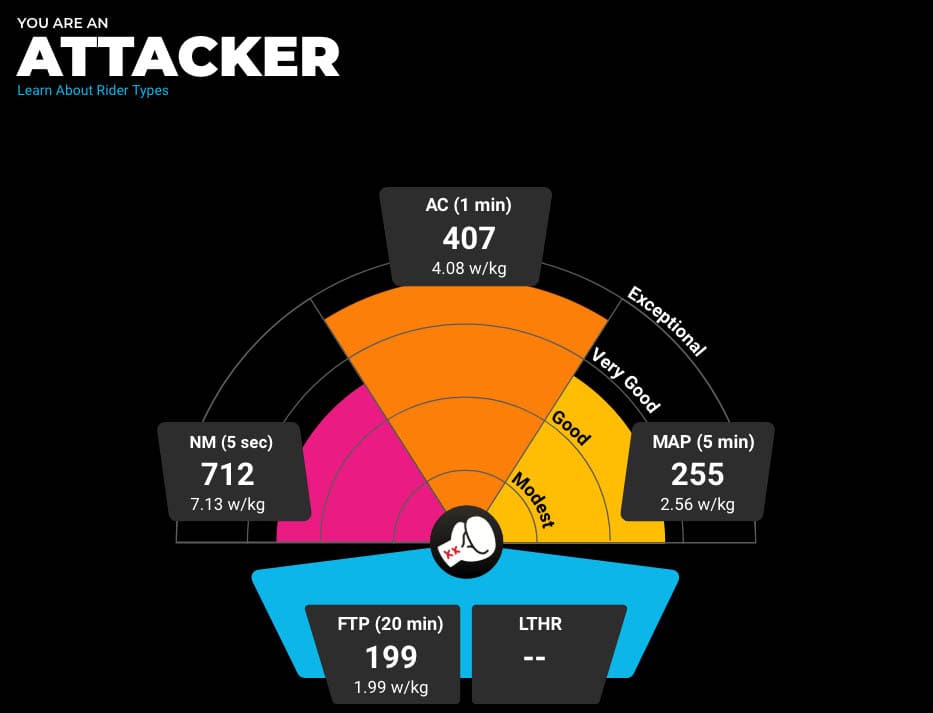
Post-Ride Notes
My crash left me with a bit of legacy pain while riding this workout. The various scrapes were mostly healed (even on my kneecap) and didn’t get in the way too much. A pulled muscle in my back complained the whole ride, but it was offset by the sheer excitement of being able to turn the pedals after 2 weeks off the bike. My god, it feels great to be on the bike again!
If I measure the value of this significant purchase in terms of enjoyment, it was money well spent. In terms of fitness value, I could have probably used the money more constructively by purchasing a more inexpensive model, but I really liked the features of the Tacx, and it is oh so quiet.
Overall, it is nice to be able to hit the pedals on rainy days – even when injured. It is a valuable member of my exercise arsenal. Its value extends beyond rainy day riding since I can easily hook it up and put a few miles in on days when I would otherwise not have time for a spin. I plan to ride this thing as often as possible…
…at least until the trails warm back up in the Spring.
